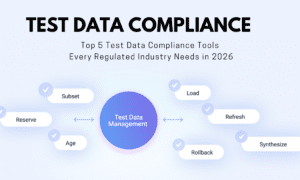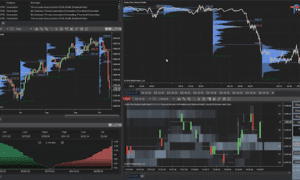In today’s fast-evolving digital economy, the ability to extract, govern, and operationalize data has become the defining factor separating industry leaders from the laggards. Amidst this transformation, a quiet force is driving high-impact change behind the scenes, building technical bridges between legacy systems, designing agile frameworks for integration, and crafting strategic roadmaps for intelligent digital ecosystems. That force is Oladimeji Hamza.

Oladimeji Hamza
A business and data systems specialist with a deep background in enterprise integration, business intelligence, and governance, Hamza is reshaping the narrative on what it means to be truly data-driven. His work, grounded in rigorous research and real-world enterprise experience, is helping businesses tackle some of the most persistent pain points in modern organizational management: disjointed platforms, data silos, migration complexity, operational blind spots, and poor alignment between IT initiatives and business strategy.
Across a series of widely cited technical contributions and frameworks, Hamza lays out practical, implementable models for digital transformation that are relevant across sectors from banking and telecommunications to manufacturing, health systems, and logistics. He speaks the language of CIOs and system architects, but also of policy advisors, compliance managers, and innovation strategists. At the core of his contributions is a singular belief: that intelligent business systems must be unified, agile, and strategically aligned to succeed in the digital era.
“Integration is no longer a luxury. It is a strategic necessity. You cannot afford to run your business on islands of disconnected data,” Hamza says. “When your CRM doesn’t talk to your analytics system or your ERP is isolated from your customer experience layer, you’re not just inefficient, you’re vulnerable.”

That vulnerability is exactly what Hamza’s work seeks to eliminate. In one of his foundational integration models, he presents a comprehensive framework for fusing Customer Relationship Management (CRM) platforms with Business Intelligence (BI) systems using agile methodologies. The approach centers on the seamless fusion of Salesforce CRM with Oracle BI and Oracle E-Business Suite, combining process modeling, data governance protocols, and stakeholder-driven requirements.
This hybrid architecture offers companies a unified ecosystem where finance, sales, compliance, and operations all communicate through a single, intelligent layer. Crucially, Hamza’s approach embeds strategic goals, and compliance needs directly into the framework. Rather than relying on top-down IT mandates or disjointed solutions, he designs architectures that reflect the daily operational realities and future growth ambitions of the business.
By incorporating EPICs and user stories a hallmark of agile development, he ensures that technical requirements are tied directly to stakeholder needs and business value. The result is a system that is not only interoperable but responsive.
“We often talk about transformation as something you switch on,” Hamza explains. “In reality, transformation is a long-term alignment between tools, processes, and people. A successful data-driven business is one that listens to its own architecture.”
That philosophy becomes even more evident in his work on data migration and infrastructure modernization. In a separate contribution, Hamza addresses one of the most complex and frequently mishandled elements of digital modernization: migrating mission-critical data from legacy environments into secure, cloud-based ecosystems.
As companies shift to hybrid or fully cloud-native models, ensuring the secure, efficient, and accurate transfer of data is essential. Downtime, inconsistencies, or poor migration planning can derail entire operations. Hamza tackles this with a robust Extract, Transform, Load (ETL) methodology that minimizes disruption and maximizes precision.
His framework facilitates seamless data movement between platforms such as Oracle BI and Salesforce. Just as important, it embraces data virtualization, an increasingly vital approach that allows organizations to access live, distributed data across systems without replicating it. This drastically reduces infrastructure cost and technical debt, while increasing agility.
“Virtualization is the future of data agility,” Hamza asserts. “You don’t always need to move data. You need to interact with it in real time, across platforms, without compromising security or performance.”
Hamza also ensures that his migration strategy fits naturally within agile environments. Businesses must now iterate quickly, deploy efficiently, and evolve in real time. His architecture reflects that demand, enabling data infrastructure to adapt alongside organizational growth and environmental change.
This becomes even more important in highly regulated environments such as financial services or healthcare, where migration is not just about performance, but compliance. With privacy laws, audit requirements, and governance frameworks growing more complex across jurisdictions, organizations need not just data mobility but traceability, accountability, and integrity.
“I always tell decision-makers: your system must be auditable by design, not as an afterthought. Governance and agility are not mutually exclusive,” he says.”
The next layer of Hamza’s enterprise contribution deals with the human dimension how strategy, structure, and systems align to produce tangible business outcomes. His strategic roadmap model is a masterclass in transformation architecture.
Rather than advocating for unstructured investment in new platforms or tools, Hamza outlines a roadmap that places business goals revenue growth, cost optimization, operational risk, and customer outcomes at the center of the digital journey. The model incorporates stakeholder alignment, KPI definition, performance feedback loops, and a risk governance overlay that ensures long-term accountability.
Hamza’s strategic framework recognizes that many digital initiatives fail not due to a lack of talent or tools, but due to misalignment. His roadmap transforms that misalignment into clarity, creating synchronized momentum between IT departments, C-suites, and cross-functional business units.
“A strategy that doesn’t translate into architecture is a slogan. A system that doesn’t measure its impact is a black box. A roadmap ties all these together,” Hamza states. “It brings visibility and accountability to transformation.”
His roadmap methodology is as relevant for fast-growth startups as it is for legacy enterprises. For emerging tech companies seeking funding, it becomes a tool to communicate strategic direction and execution discipline. For multinationals, it provides a lens through which to prioritize transformation investments, measure ROI, and coordinate change across geographies.
Hamza is also deeply aware of the evolving expectations around risk and regulatory transparency. In today’s environment—where cybersecurity, data ethics, and AI governance are under intense public scrutiny his model bakes risk awareness into the transformation journey from the very beginning.
By embedding risk controls into performance dashboards, and using compliance workflows to guide system design, Hamza ensures that digital transformation does not become a compliance liability.
“Risk is not just about what might go wrong. It’s about what you failed to anticipate,” he warns. “When you plan for resilience from day one, you don’t just survive shocks—you absorb them and grow stronger.”
Industry leaders have taken notice. Across North America, where Hamza’s frameworks are already being implemented in leading financial institutions and infrastructure firms, there is growing recognition that transformation is no longer a tech initiative it’s a strategic imperative.
His frameworks are also attracting attention from innovation hubs and policy institutions working on national digital infrastructure. As governments and enterprises prepare for the coming wave of AI integration and digital public infrastructure, Hamza’s work is a blueprint for how to design systems that are secure, ethical, responsive, and scalable.
He has emerged as a rare figure: one who can speak fluently in the language of enterprise systems architecture and articulate the strategic logic behind transformation investment. This dual fluency makes him an indispensable voice in the conversation on intelligent business systems.
For industry leaders, Hamza’s work offers significant, immediate value:
- His platform integration models empower businesses to break data silos and drive unified insights across CRM, ERP, and BI platforms.
- His migration and virtualization strategies ensure secure, compliant, and non-disruptive digital modernization.
- His strategic roadmap model aligns technology with measurable business objectives, enabling organizations to demonstrate ROI, track KPIs, and manage transformation risk.
“My goal is not to sell a model. My goal is to make transformation achievable without chaos, without misalignment, and without compromise,” Hamza reflects.”
This mindset rooted in problem-solving rather than performance theater may explain why his work resonates so widely. From financial analysts managing risk portfolios to CIOs designing multi-cloud environments, Hamza’s models provide clarity in a landscape often marked by jargon, fragmentation, and hype.
And unlike many frameworks that remain academic or theoretical, Hamza’s are grounded in industry-specific deployment. His models are being used to support real-time reporting in cloud banking environments, to optimize cross-channel customer engagement, and to enable AI-readiness in data-heavy compliance sectors.
As global markets face escalating demands for transparency, agility, and trust, it is voices like Hamza’s that offer direction. His work is not just a contribution to the literature of enterprise systems it is an evolving operating manual for how modern organizations can stay intelligent, resilient, and strategic in the face of relentless change.
“At the end of the day, systems should serve people. That means leaders, customers, regulators and future generations. That’s what responsible architecture looks like,” he concludes.”
Oladimeji Hamza’s research and frameworks offer more than just technical solutions. They offer a philosophy of clarity, accountability, and sustainable innovation. For any organization serious about modernization, compliance, and long-term impact, his insights are not just recommended. They are essential.


































